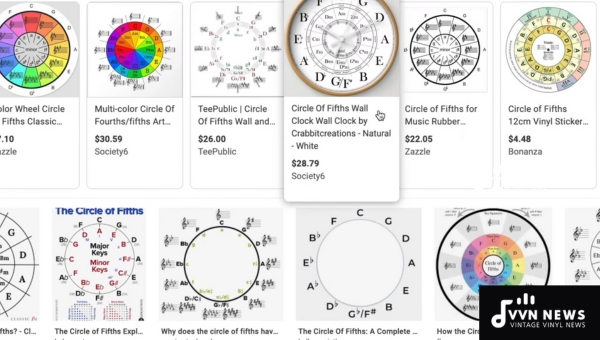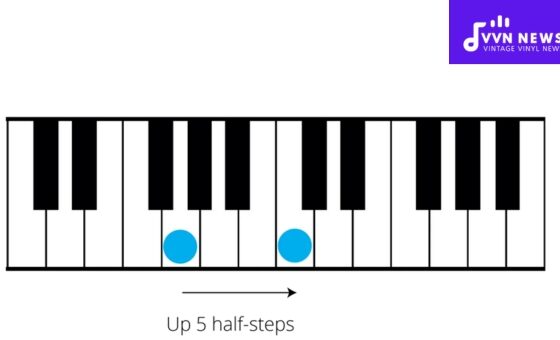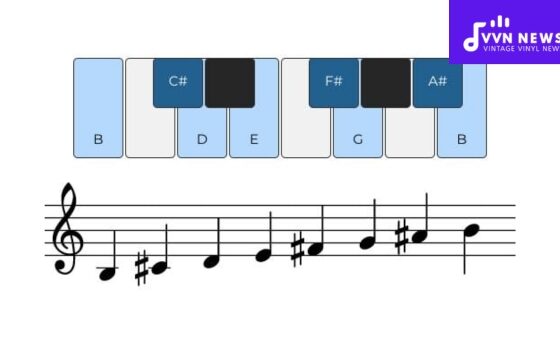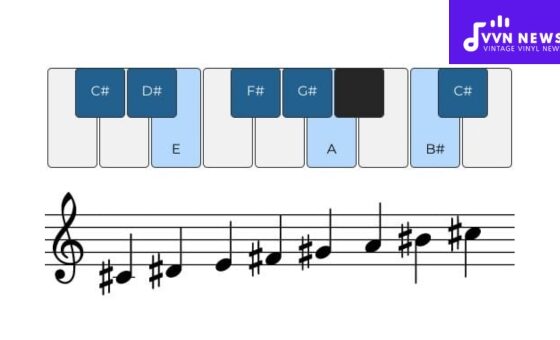If you’ve ever ventured into music theory, chances are you’ve encountered the Circle of Fifths. Often touted as a miraculous diagram, it is brimming with a wealth of harmonic knowledge that can benefit musicians of all levels.
Today, we’re taking on the task of simplifying this mighty circle. I’ll break down ‘The Circle of Fifths explained’ to help ignite your understanding and unlock its many musical secrets!
The Circle of Fifths might look like an intricate astrology chart for those unfamiliar with it. But rest assured, there’s no mystery or complication if it’s approached correctly.
This tool is not just for classical composers or jazz improvisers; anyone can harness its power to create better music, whether you’re a songwriter penning your tunes or a budding musician getting familiar with chords and scales.
We’ll work together to understand this exciting facet of music theory and how we can apply it practically in our musical journeys.
The Circle Of Fifths Explained
The Circle of Fifths is a visual representation of the relationships among the 12 tones of the chromatic scale. It serves as a tool for musicians to identify and understand key signatures, fundamental relations, and the creation of melodies and harmonies in music.
Starting at the top with the key of C Major (which has no sharps or flats), you move clockwise, adding sharps.
Moving counterclockwise, you add flats. As you traverse the circle by fifths upwards, each note is a fifth above the last, whereas each downwards traveling note is a fourth above the previous.
Significance in Music Theory
The Circle of Fifths is imperative in understanding music theory, from critical signatures to chord progressions.
It allows you to figure out which notes belong to a specific key and also aids in understanding harmonic progressions within a song.
For composers and musicians alike, mastering the Circle of Fifths is akin to acquiring an essential navigational device on their creative journey.
It guides and illuminates entire landscapes of harmony inaccessible otherwise. It’s like having your very own music theory GPS.
Also Read: 10 Ways To Include Music Theory In Your Lessons [Practical Tips]
The History and Evolution of the Circle of Fifths

The concept of the Circle of Fifths dates back several thousands of years, with its origins rooted in early mathematical understandings of sound and music.
Origins and Early Development
The Circle’s creation is often credited to Pythagoras, a mathematician in Ancient Greece known for his contributions to music theory.
He discovered that sounds we find pleasing or consonant, have simple mathematical ratios. For example, the balance 3:2, known as the “perfect fifth,” lies at the heart of the Circle Of Fifths.
The Role Of Key Figures
Later on, in the 1670s, physicist and astronomer Johann David Heinichen formalized the intersection between these ratios and tones’ sequence into what we now know as the Circle of Fifths.
Johann could illustrate the relationships between each musical key visually through a full circle divided into twelve individual sections representing each note.
Evolution Over Time
As Western music evolved over centuries from modes (medieval scales) to major-minor tonality (keys), so did the Circle Of Fifths.
It absorbed this evolution within its structure, becoming an essential tool for intuitively navigating around different keys and scales.
The late 17th century saw many significant music theorists shape modern understanding of the Circle Of Fifths.
Some noteworthy figures include Jean-Philippe Rameau and Heinrich Schenker, whose work refined its application harmoniously.
Understanding the Components of the Circle
To fully appreciate the circle, let’s dissect it and dive into each component.
Different Segments of the Circle Explained
The circle is divided into 12 points around its circumference to represent each of the 12 notes in music.
These notes include seven natural notes (A, B, C, D, E, F, G) and five accidentals (C#/Db, D#/Eb, F#/Gb, G#/Ab, A#/Bb), making up an octave.
Starting from C at the top and moving in a clockwise direction around the circle brings you through twelve steps along a chromatic scale.
Each successive pitch is seven half-steps (a perfect fifth interval) from its predecessor. In other words:
- C to G – 7 half-steps
- G to D – 7 half-steps
- D to A – 7 half-steps
- A to E – 7 half-steps
- E to B – 7 half-steps
- B to F#(Gb) – 7 half-steps
- F#(Gb) to Db(C#) – 7 half-steps
- Db(C#) to Ab(G#) – 7 half-steps
- Ab(G#) to Eb(D#) – 7 half-steps
- Eb(D#) to Bb(A#) – 5 half steps,
- Bb(A#) back to F – 5 Half steps.
A traveler can visualize the relationship between different keys and their relative signatures by going around the circle.
Each segment around the circle represents a unique key with its distinct set of sharps or flats.
This makes it easy to identify the critical signatures of different keys and how they relate.
Role of Major and Minor Keys
Inside the outer ring represented by primary keys is an inner circle of their relative minor keys.
For instance, “A minor” is nestled within “C Major” because they draw from the same selection of notes, starting at a different point along the sequence.
As displayed on the Circle of Fifths, this all-important linkage between corresponding major and minor keys presents us with an incredible range of compositional possibilities.
A familiar navigational tactic composers employ is moving through pieces by transitioning from a primary key into its relative minor (or vice versa).
Hence, understanding these relationships can significantly enhance one’s music creation or appreciation potential.
For each significant key on the Circle of Fifths, its corresponding relative minor key resides precisely three steps counterclockwise along the circle’s pathway.
If looking at C Major, take three steps counterclockwise around the Circle (or a minor third interval’), bringing you comfortably into ‘A Minor.’
In conclusion, the Circle Of Fifths is a profound resource for anyone interested in understanding music theory.
By mastering its components and familiarizing themselves with the relationships between various notes and chords, musicians can elevate their creativity while gaining greater depth in understanding musical structure.
Understanding Key Signatures through the Circle of Fifths
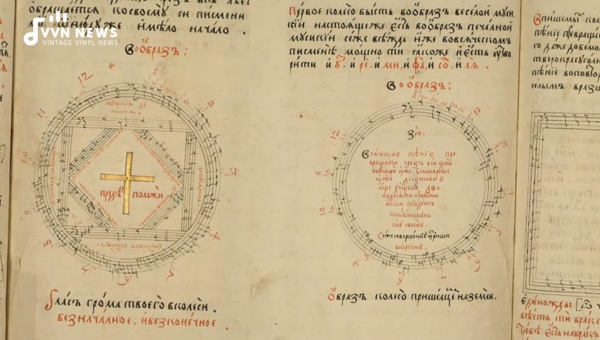
Perhaps the most crucial musical application of the Circle of Fifths is its role in shaping and defining key signatures.
Revealing sharps and flats inherent within each key, it demystifies the components of Western music’s distinct tonal landscapes.
What are Key Signatures?
A key signature represents clusters of sharps or flats that denote a specific musical key.
It’s a fundamental element at opening measures in sheet music and specifically defines what scale (or scales) the composition is based on.
For instance, if I see two sharps (F# and C#) at the beginning measures, I can confidently assert that the piece corresponds to D major or B minor, based on my understanding of the Circle of Fifths.
Navigating Key Signatures with The Circle Of Fifths
We dive deeper into flat keys as we move counterclockwise around the Circle of Fifths.
Start with C Major (which owes simplicity to having no sharp or flat) and move to the next fifth, F Major – you will observe a single balance being added. Continue to Bb Major, and another flat arrives.
This cycle continues throughout our journey until all seven flats become visible in Cb Major.
Similarly, when we traverse clockwise from C Major, we penetrate a world where sharp keys dominate.
Moving first to G Major adds an F# onto D Major, accumulating another sharp note; this pattern repeats until all seven sharps appear in C# Major.
This circular arrangement gives us an incredibly effective way of remembering critical signatures associated with a given number of flats or sharps, which assists in playing scales correctly and dramatically enhances improvisational skills!
Witnessing how the Circle of Fifths shapes our mu sical understanding is another example of how mathematics dances intricately with art.
Also Read: 15 Ways To Incorporate Music Theory [Boost Your Music Knowledge]
Importance of the Circle of Fifths in Music Theory
Understanding the importance of the Circle of Fifths in music theory is like uncovering a secret language that lies beneath the facade of every melody and rhythm.
It helps musicians scratch beneath the surface, offering an alternative way to visualize and internalize music theory’s cardinal principles.
Establishing Key Signatures
One of the essential functions of the Circle is to help you quickly identify vital signatures – which notes are sharp or flat within a specific scale.
If we start at “C” at the top (twelve o’clock position) on our circle and move clockwise, each note moved towards adds a sharp (#).
Each key (starting from C) sharpens its key signature in our journey around this circle.
For instance, let’s start with the ‘C’ major, which has no extra sharps or flats. If we move a fifth higher, we reach ‘G,’ with one sharp (F#).
Continuing this pattern will allow us to establish all key signatures for significant scales around our Circle.
Critical signatures for minor keys work similarly but start from ‘A’ Minor (which also has no sharps or flats).
Modulation
Modulation is another area where our understanding of the Circle of Fifths can come into play.
It’s a switch from one musical key to another within a piece. This technique keeps the listener involved by creating variation and emotional dynamics, keeping them hooked on your song.
Regarding modulation, adjacent keys on the circle have strong relationships – they share many standard notes yet offer enough difference to make interesting harmonic progressions.
A composition might start in C major, then modulate up a fifth to G – retaining most existing players while adding an F#.
Unveiling Chord Progressions Within The Circle
The Circle doesn’t only help us understand keys but chords as well. Many familiar chord progressions are closely tied to this concept.
Primary chords in any key are I, IV, and V (1st, 4th, and 5th degrees). For instance, in ‘C’ central, these primary chords are ‘C,’ ‘F,’ and ‘G.’ Notice anything familiar? Yes! These notes lie adjacent to our circle!
Existing within this harmonic crystal ball is an astounding amount of information that can revolutionize not only how you understand music but how you compose it as well.
The Mathematical Aspect Behind the Circle of Fifths
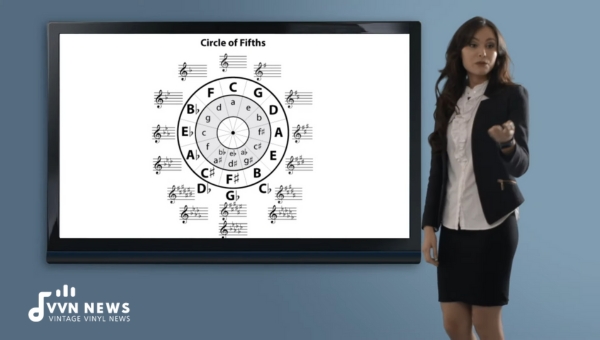
Music, after all, is a sonic expression of mathematics. It involves frequencies, intervals, and patterns interwoven in complex mathematical relationships.
At the heart of this interplay lies the Circle of Fifths, which embodies these mathematical concepts elegantly.
Understanding this relationship can illuminate the mystical labyrinth of Western music theory and even enhance our ability to tune musical instruments.
Relationship Between Frequency Ratios and Musical Intervals
In music, an interval refers to the distance between two pitches. Western music is built upon certain specific intervals which are uniform regardless of the starting pitch.
The fundamental logic behind arranging pitches in a Circle of Fifths stems from one such interval: the perfect fifth.
A perfect fifth is produced when two frequencies feature a ratio of 3:2.
For example, if one pitch has a frequency of 200 Hz, then a perfect fifth above this would be a pitch with a frequency 1.5 times that, i.e., 300 Hz.
These ratios aren’t arbitrary – they’re rooted in physics and how our brains perceive sound.
The simpler the ratio (with 1:2 (an octave) being the simplest), the more consonant and pleasing it sounds to our ears.
Every successive note in the Circle of Fifths represents an increase by a perfect fifth interval from the previous message (or a decrease if you move counterclockwise).
But as we cycle through these fifths, we don’t immediately start repeating notes after completing the first few steps – we encounter all 12 unique pitches before returning to the starting pitch.
How It Influences Musical Tuning
The implicit harmony within frequency ratios provides an intuitive way to tune musical instruments while leaning beautifully toward constructing the Circle of Fifths.
Early music systems were founded on this ‘Pythagorean tuning,’ where string lengths (or other properties depending on the instrument) were adjusted precisely for each note so that perfect fifth relationships retained simplicity across all traditional keys.
However, Pythagorean tuning doesn’t quite fit perfectly within the framework dictated by a circle; there’s a discrepancy known as the ‘Pythagorean Comma,’ which creates complications, especially while transposing music across different keys.
This limitation eventually paved the path for well-tempered tunings like “Equal Temperament Tuning,” widely adopted today for Western classical music & most modern keyboards or fretted stringed instruments where every adjacent pair gets separated by the same interval.
Thus balancing off each key’s tuning slightly but creating overall consistency that bridges the disparity left by Pythagorean Comma without losing too much underlying harmony rendered from those original principles.
Hence, understanding these fundamentals deciphers hidden math woven into the fabric of Western music theory and connects musicians with rich lineage leading back centuries ago when all these principles were initially being discovered & refined.
Also Read: Romantic Music Period [Key Characteristics & Famous Composers]
Using The Circle Of Fifths For Composing & Harmonizing Melodies
Whether you’re an ardent composer or a blossoming beginner, the Circle of Fifths is a continually rewarding and crucial tool in your musical toolkit.
It can help unearth new chord progressions, unveil potential harmonic movements and transformations, and provide solid groundwork for understanding melodies.
A Tool for Music Composition
As budding composers initially start to explore composition, it can often seem daunting to figure out where to begin or how to design melodic lines.
The Circle of Fifths is beneficial here. It’s the perfect guide offering repeated patterns that dictate harmonious relationships between notes and chords.
Start on any note within the circle and progress in either direction.
Moving in a clockwise direction (or ‘fifths’) emphasizes ‘dominant’ relationships between chords, whereas moving counter-clockwise (or ‘fourths’) emphasizes ‘subdominant’ relations.
This knowledge alone can significantly enhance your approach toward composing – opening up pathways for more diverse and engaging melodies.
Encourage yourself to experiment with chord progressions based on movements within the Circle of Fifths. An example could be the II-V-I progression commonly used in Jazz composition.
The Circle as a Harmonization Guide
In addition to being great for creating compelling compositions, the circle is superbly helpful when harmonizing melodies.
It instantly allows you to find suitable matching chords for any given melody line.
Suppose you have a melody composed mainly from the notes of the C Major scale (C, D, E, F, G, A, B).
If you follow around the Circle of Fifths, all these notes sit adjacent to one another (C sits next to G, which sits next to D, and so on).
Each point in that segment of the circle corresponds with a related major or minor chord that you can use to harmonize your melody.
The artful use of harmonizing melodies by utilizing the Circle Of Fifths transforms a ‘good’ composition into an ‘extraordinary’ one.
This method can be fruitful when attempting to re-harmonize existing pieces to give them a fresh lease of life or your personal touch.
FAQs About Circle Of Fifths
Who invented the circle of fifths?
The circle of fifths was invented by a Ukrainian man named Nikolay Diletsky.
How did Pythagoras discover the circle of fifths?
Pythagoras experimented with string lengths, vibration speeds, and frequencies. He found out that when a string length is halved (creating a 2:1 ratio), it produces a note one octave higher, and his continuous mathematical evaluations led to the discovery of the circle of fifths.
What are all 12 keys in music?
Music has seven significant keys (C, D, E, F, G, A, B) and five minor keys (C-, C#, D-, D#, E-) totaling twelve.
What is the key signature in music?
A key signature is a set of sharp or flat symbols placed together on the musical staff, indicating which pitches are to be consistently played as sharp or flat throughout the piece.
What chords are in the key of C?
The chords present in the Key of C include C Major (C), D Minor (Dm), E Minor (Em), F Major (F), G Major (G), A Minor (Am), and B Diminished (Bdim).
Conclusion
Understanding the Circle of Fifths may initially seem like unraveling a complex scientific theorem. However, it is far more straightforward than it appears.
Grasping this critical music theory concept empowers us to delve deeper into the fascinating world of harmonies, chords, and scales.
It serves as our musical compass by leading the way in composing, arranging, and even improvising music.
When unraveled and examined up close, we can appreciate that the Circle of Fifths is a source of music theory wisdom and a profound symbol for the beautiful symmetry within the music itself.
